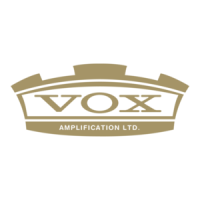
Do you have a question about the Vox MINI GO 3 and is the answer not in the manual?
| Tempo range | 40 - 240 bpm |
|---|---|
| Amplifier class | - |
| RMS rated power | 3 W |
| Number of speakers | 1 |
| Speaker driver size | 5 \ |
| Audio output channels | - channels |
| Preset rhythm patterns | 33 |
| Sound effects quantity | 8 |
| Microphone in | Yes |
| Headphone connectivity | 6.3 mm |
| Connectivity technology | Wired |
| Suitable for | Acoustic-electric guitar |
| Product color | Black |
| Volume control | Rotary |
| Power source type | AC, Battery |
| Depth | 180 mm |
|---|---|
| Width | 256 mm |
| Height | 249 mm |
| Weight | 3500 g |
Features nine amp sounds using VET modeling, plus vocoder and line settings for various instruments.
Includes eight high-quality effects: three modulation, four delay/reverb, and one octave effect.
Offers 33 rhythm patterns with a wide range of variations for practice and performance.
Allows tuning of connected guitars or basses via the INPUT terminal.
Provides a user-friendly looper for jam sessions, usable with the rhythm function.
Can be powered by commercially available mobile batteries.
Features AUX IN and MIC IN jacks for connecting external audio devices and microphones.
Compatible with the VFS3 footswitch for controlling rhythm and looper functions.
Describes the INPUT jack, MIC IN jack, TRIM, and SEND knobs for audio and microphone input.
Covers the AMP selector, GAIN, TREBLE, BASS, and VOLUME knobs for amplifier settings.
Explains the EFFECTS knobs 1 and 2, and the TIME button for adjusting modulation, octave, delay, and reverb effects.
Details the genre selector, VARIATION button, TEMPO button, RHYTHM LEVEL knob, and START/STOP button for rhythm patterns.
Describes the LOOP LEVEL knob and LOOP button for recording, playback, and erasing loops.
Explains the PROGRAM button for selecting user programs or manual mode (VOX MINI GO 50 only).
Details the Power button, AUX IN jack, and PHONES jack for power, audio input, and headphone output.
Illustrates and describes rear panel connectors like DC IN, FOOT SW, and USB-C.
Instructions on how to use the amplifier's built-in stand for angling.
Explains the automatic power-off feature and how to enable/disable it.
Details how to select rhythm patterns, start/stop, adjust volume, and change tempo.
Step-by-step guide on the fundamental operations of the looper function.
Table detailing LOOP button states, short-press, twice-press, and hold operations.
Describes how to use the looper in conjunction with the rhythm section, including quantization.
Details how rhythm tempo affects looper recording and playback, including tempo adjustment.
Explains how to play rhythm and looper together, including relative position and tempo adjustments.
Guide on how to use the built-in tuner to tune the guitar accurately.
Steps for activating the tuner, playing strings, and reading the pitch indicators.
Explains how to interpret the LED indicators for sharp, flat, and in-tune notes.
How to save, recall, and use user programs and manual mode on the VOX MINI GO 50.
Instructions on saving custom sounds as user programs A, B, or C.
Procedure to reset all amplifier settings to their original factory defaults.
How to connect and use the optional VFS3 footswitch for hands-free control.
Steps to reassign functions to the footswitch buttons.
Detailed guide on entering and using the mode to customize footswitch assignments.
A reference list of functions assignable to the footswitch and their operations.
Further explanations for specific footswitch functions like Tuner, Looper, and Rhythm.
Detailed descriptions of each amp model and effect type available on the amplifier.
Overview of the different amplifier models, including their characteristics and historical context.
Describes Chorus, Phaser, Tremolo, and Octave effects and their controls.
Explains A.DLY, D.DLY, SPRING, and HALL delay/reverb effects and their controls.
Describes the BRIT 800 amp model, a UK-manufactured 100W hard rock amplifier from the 80s.
Details the BRIT VM amp model, a 100W English amp head with a powerful tone and tight low-end.
Describes the SL-OD amp model, an overdrive channel amp with a compressed mid/high range.
Details the DOUBLE REC amp model, featuring deep low-end and sparkling highs for extreme gain settings.
Explains the VOCODER effect, which adds a talking modulation to the guitar sound.
Describes the LINE setting for clean tones, suitable for acoustic guitars or keyboards.
Checks for power-related issues, including AC adapter and mobile battery connections.
Troubleshooting steps for issues with guitar signal, volume, and connections.
Specific checks for sound output issues when using the VOCODER.
Advice on increasing amplifier volume, including checking guitar and battery levels.
Steps to resolve issues with rhythm section audio output.
Explains why rhythm tempo might change unexpectedly, e.g., with looper use.
Solutions for when looper recording fails, e.g., incorrect input source.
Troubleshooting steps for microphone input sound issues.
Checks for issues preventing effects from being applied, like tuner activation or knob settings.
Explains how footswitch functions can be unintentionally changed and how to prevent it.
Technical specifications for the VOX MINI GO 3, 10, and 50 models.
Details power consumption for different models and power sources.
Lists the physical dimensions and weight of each VOX MINI GO model.
Links to download manuals and software for the amplifier.
Links to other relevant VOX product manuals.
